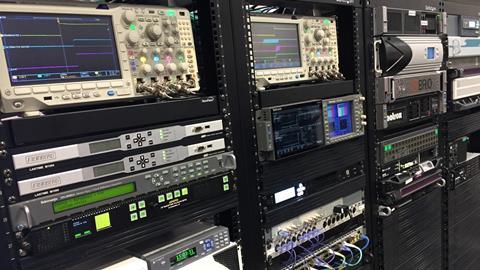The ongoing journey towards IP has resulted in unprecedented levels of cooperation, says Stan Moote.
What started as a germ of an idea in the middle of last year has flowered into an amazing demonstration of what can be made to happen when people from different organisations and competing companies work together towards the common good.

The IP Showcase at IBC this year will be the most powerful demonstration yet of the result of working together towards a common goal; IP interoperability has been accelerated into a practical way forward for the industry as it races to keep ahead of changing technology and business models. Transitioning to an IP-based infrastructure isn’t just about replacing SDI wholesale with a newer technology.
IP offers far reaching benefits not available in a fixed SDI-type environment of both scalability and the flexibility to be able to reconfigure workflows on demand as requirements change.
Moving to IP also doesn’t require a wholescale ‘forklift’ replacement of existing SDI systems – a hybrid IP/SDI, staged approach is also achievable.
IABM was part of consortium that worked with IBC to deliver the world’s first IP interoperability zone at IBC2016 – in partnership with AES, AIMS, AMWA, EBU, SMPTE and VSF, together with around 30 vendors.
All worked together to demonstrate interoperable IP signal flows between their products. The key objective of all the parties was to educate and inform visitors on the standards and creative opportunities offered by realtime IP signal flows.
The stand was buzzing throughout the show – demonstrating a practical path to an IP future had captured visitors’ attention powerfully.
As IABM CEO Peter White said at the time: “The realisation of the IP interoperability Zone at IBC, with so many different vendors and end-users getting behind it, is an expression of the industry’s common purpose.
“This shared vision will remove the roadblock that uncertainty over standards and interoperability has put in the way of end-users’ decisions to transition to the many potential operating and cost benefits of IP technology in the broadcast production chain.”
An expanded group carried the idea forward at NAB this year, with more vendors and associations involved – and 60+ products on show demonstrating real-world IP signal flow interoperability in the IP Showcase.

As at IBC2016, the booth was packed with visitors throughout the show.
Education was again a key objective alongside the practical demonstrations. Non-stop theatre presentations, curated by IABM, covered the full gamut of knowledge for realtime IP production and intra-facility distribution.
Topics such as full and hybrid IP infrastructures; virtualization, explanations of the up and coming IP SMPTE ST 2110 standard; SDI to IP migration strategies; automated device discovery and registration; SMPTE ST 2110 and AES67 audio; the new sync and timing with ST 2059; and a number of real-life case studies of IP facility installations were all covered.
The move to IP signal flows was becoming unstoppable.
SMPTE ST 2110 had passed through all the technical hoops and was in the final throes of ratification. In April, the Alliance for IP Media Solutions (AIMS) surveyed its members that are vendors with this question: “Will your company be shipping SMPTE ST 2110 product to market in 2017 (not including alpha, beta or proof of concept)?” Of the 26 AIMS members that responded to the survey, a great majority - 72% - stated YES they would have product on the market before the year end.
In May at BroadcastAsia 2017, IP was again featured with a regional focus.
The IABM theatre featured presentations from ABU (Asia-Pacific Broadcasting Union), AIMS and IABM members speaking about benefits of IP installations they have been working on. Right next door was the Broadcast IP Inter-Op Lab.
Presented by APB, BroadcastAsia and Ideal Systems, the IP Inter-Op Lab included a live broadcast studio, content editing and distribution to OTT – all in realtime - with equipment supplied by 16 leading IP vendors to demonstrate real-world IP interoperability.
Common roadmap
Fast forward to IBC2017 and the IP Showcase is certain once again to be a major exhibition draw.
Realtime, uncompressed IP is no longer a ‘future’ – it is here, and now. A visit to the IP Showcase will confirm that realtime IP production is a practical, flexible, efficient reality that is now taking hold in mainstream broadcast operations.
Visitors will be able to learn about the new SMPTE ST2110 suite of standards and see their benefits in action thanks to more than 40 vendors working together to demonstrate real-world IP interoperability based on the common roadmap.
The interoperability demonstrations will be divided into logical application pods – live production signal flows, contribution and playout signal flows etc, all shown under the control of familiar user interfaces – proving ease of use as well.
In the co-located IP Showcase Theatre, again curated by IABM, visitors will hear about the rapidly increasing number real-world IP deployments from broadcasters who have already embraced IP signal flows.
They will also learn about the business and creative benefits of IP, and how they can be applied to their own operations. With no direct sales agenda on the booth, the IP Showcase is dedicated to educating and energising all IBC visitors, lowering barriers to entry and removing the angst from IP. The IP Showcase is conceived to help build a more flexible, more efficient and more creative broadcasting industry to delight audiences and create value.
In just 15 months, thanks to the dedication of an inspired group of organisations and companies, IP has been transformed from an object of fear to many to wide acceptance as the right way forward for our industry.
Never before in more than 30 years in this industry have I seen such concord and cooperation between so many disparate and competing vendors.
And perhaps never before has our industry had such an opportunity to embrace new technology to deliver radical business transformation.
Stan Moote is Chief Technology Officer at IABM and has worked worldwide in the industry for over three decades.

























No comments yet